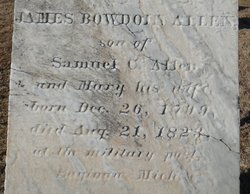Bicentennial of Fort Saginaw: Lt. Allen
- jvannette5
- Jul 21, 2022
- 4 min read

July 22, 2022, marks the 200th Anniversary of the establishment of Fort Saginaw. This short-lived project had long lasting effects. To acknowledge the milestone year, the Castle Museum shares a series of historical posts this week.
You can read the other two posts in this series: Bicentennial of Fort Saginaw: Establishing the Fort on the Saginaw River and Bicentennial of Fort Saginaw: Consequences.
You can also visit the permanent exhibit on the lower level of the museum to learn more.
A small trunk provides a poignant connection to the story of Fort Saginaw.
Its original owner was Lieutenant James B. Allen, one of the soldiers who died from malaria at Fort Saginaw. Constructed of pine covered with animal hide, the trunk’s top is ornamented with tacks forming the initials “JBA” - John B. Allen. At first glance it appears to be a simple item made on the frontier. However, closer study reveals that it is a finely crafted piece of luggage. Fragments of a printed label seem to indicate that it was purchased in Allen’s home state of Massachusetts.
James B. Allen and his twin brother, John Jay Allen, were born on December 26, 1799, in Newburyport, Massachusetts. Their father, Samuel C. Allen was an attorney and politician who served in the United States Congress from 1817 until 1829. James B. Allen would become a Second Lieutenant at the military post in Saginaw.
Although Fort Saginaw was located on high ground, water flooded the surrounding marshes and created a perfect breeding ground for mosquitoes. In the summer of 1823, most of the members of the post contracted a mosquito-borne illness – a form of malaria. Even the medical officer contracted it. To care for his patients, he was carried from cot to cot until a replacement officer arrived from Detroit. Before the post was abandoned, nine people, officers and enlisted men and several civilians, died.
Lieutenant James B. Allen was 23 when he passed away on August 21, 1823. Major Daniel Baker, the commander of Fort Saginaw, noted that was held in high esteem by his fellow officers.
After Allen’s death, his trunk “was sent back to Massachusetts where it became a treasured possession of Lieutenant Allen’s twin brother, John J. Allen. On the way unfortunately, it was broken open and its contents stolen, but the trunk was delivered intact. After John Allen’s death, the memento remained in an attic for several years until his daughter, Mrs. Jennie Whipple, who lived in Saginaw, obtained the trunk in 1910” (The Saginaw Daily News, June 28, 1934).
A letter from Daniel Baker, the former commander of Fort Saginaw, to Samuel Allen, suggests the concerns of the bereaved father:
“ . . I have consulted our mutual friend, Judge Sibley, who concurs with me in opinion, that it should be impractiable [sic.] at present to remove the remains of your lamented son, but that ultimately they should brought to the place or removed to some public burying grounds, near at hand. In the meantime they will remain perfectly secure from interuption [sic.], as there is on the spot a confidential person employed by the government for the preservation of the public property at Saguana. I should also mention that the place of internment is sufficently [sic.] indicated by a monument of brick, enclosed by a railing of sutiable [sic.] construction. Material for a permanent monument might be had here but of inferior quality and at an expense little, if any, of what they would cost at Albany, from whence they are more frequently brought to this place. I would therefore by all means recomend [sic.] you to process them there, whenever the purchase shall become necessary.
(Major, D. Baker, Letter to Honorable Samuel C. Allen, March 7, 1825. Transcription in Local History and Genealogy Collection, Hoyt Library)
Major Baker’s promise that the burial site was sufficiently marked, proved to be optimistic. Within a few years Saginaw City was platted. While there are accounts of the buildings of the former fort providing shelter for pioneer residents, there is no mention of the post’s cemetery or monuments marking the burials.
On May 15, 1884, workers preparing to lay new pavement on South Washington [Now South Michigan] near Cass Street discovered at least three human skeletons in coffins. It was assumed they were the burials of the soldiers who died at the fort. Saginaw residents contacted the military for information about the soldiers who died at the front and received the following list from S.V. Benet, Brigadier General, Chief of Ordinance and Acting Secretary of War:
“Names of the officers and enlisted men who died at Saginaw, Mich. while a military post:
J.D [sic.]. Allen, second lieutenant, Third infantry, died Aug. 12 [Sic.] 1823.
H.N. Baker, first lieutenant, Third Infantry, died Oct. 12, 13, 1823.
John Fitch, corporal, Company H, Third infantry, died Aug. 21, 1823. David Nichols, private, Company K, Third infantry, died June 25, 1823. James Dolan, private, Company H, Third infantry, died Sept. 25, 1822.
John Staniford [Stainfort], private, Company H, Third infantry, died June 9, 1823. Sam F. Shannon, private, Company H, Third infantry, died June 9, 1823. William Clark, private, Company H. Third infantry, died Aug. 28, 1823. Joseph Hecton, private, Company K. Third Infantry, died Sept. 25, 1823. Records fail to show place of internment, Adjutant general’s office, June 14, 1881.”
According to various accounts from the 1880s, the remains were reinterred in Oakwood Cemetery.
While the exact location of his remains is unclear, Lieutenant J. B. Allen's family erected a marker for him in the family’s burial section of Center Cemetery, Bernardston, Massachusetts. The lettering on one side of a simple marble obelisk reads:
James Bowdoin Allen
Son of Samuel C. Allen
and Mary his wife
born Dec. 26, 1799,
died Aug. 21, 1823
at the military post
Saginaw, Mich.












